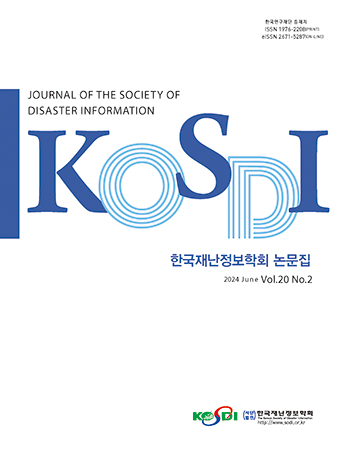Research Article
Abstract
References
Information
Purpose: In fact, to manage response and recovery successfully, although mitigation and preparedness should be accomplished naturally and automatically through thorough analysis and assessment, response, recovery, mitigation, and preparedness have not done in the way of virtuous cycles and continued broken disaster management repeatedly. Method: By Analysis through the critical methods, to enhance the community disaster resilience centered by social disaster management system in Korea, Result: ① public training & education preparing for emergency or disaster ② supplying public with disaster, or hazards information, and sharing at real time ③ networking emergency and disaster informational communication system & alarm system ④ analysis and assessment of risk(or disaster) in community ⑤ inter-governmental cooperative relationship and agreements ⑥ adopting and implementing disaster or hazards mitigation plan Conclusion: These will be able to be fully melt down into and specifically focused in the disaster policies in Korea for the better disaster management.
연구목적: 사실 재난대응을 잘하기 위해서는 발생한 재난에 대한 철저한 분석과 평가로 자연스럽게 완화 및 대비가 이루어져야 했어야 함에도 불구하고 「대응 → 복구 → 완화 → 대비→ …」가 선(善)순환적으로 작동되지 않아 분절적 재난관리가 반복되었다. 연구방법: 여러 다각적인 연구방법 및 분석을 통해 결국 사회재난 중심 재난관리체제인 우리나라에서 지역사회의 재난회복력을 높이기 위해서는 연구결과: ① 「시민 안전교육 및 훈련」 ② 「시민대상 실시간 재난정보제공 및 공유」 ③ 「재난정보 및 경보시스템 네트워크(연결망) 구축」 ④ 「재난분석과 평가(위험성 및 취약성 평가)」 ⑤ 「재난완화계획」 ⑥ 「정부 간(間) 협조체계 구축」 등 주요 구성요소가 재난관리정책에 구체적으로 반영되어 실현되어야 함을 검증하였다. 결론: 이제는 더 이상 악(惡)순환적 또는 단절적 재난관리가 아닌 선(善)순환적 연결된 재난관리가 되어야 한다. 재난관리를 더 잘하기 위해서는 완화 및 대비 영역에서 재난대응에 영향을 주는 재난회복력 주요 구성요소가 재난관리의 선(善)순환적인 연결고리에 작동할 수 있도록 재난관리정책에 우선적으로 반영되어야 할 것이다.
- Douglas, P., David, J. (2006). DISASTER RESILIENCE, CHARLES C THOMAS·PUBLISHER, LTD. pp. 4-6.
- George, D., Haddow, J. A. B., Damon P. C. (2011). Introduction to EMERGENCY MANAGEMENT, Butterworth- Heinemann, United Kingdom.
- Glavovic, B. C. (2005). Social resilience: "building layers of resilience to transcend waves of adversity." Resilient Infrastructure Conference, Massey University.
- Kinosita, E., Ooya, T. (2012). Strategic Decision Making Technique, AHP, Cheonram, Seoul, pp. 15-17.
- Manyena, S.B. (2006). The concept of resilience revisited. Disaster, Vol. 30, No. 4, pp. 433-450. 10.1111/j.0361-3666.2006.00331.x 17100752
- Schneider, R.O. (2006). Disaster Resilience, Hazard Mitigation: A Priority for Sustainable Communities, pp.66-71.
- Walker, C., Broderick, J. (2006). The Civil Contingencies Act 2004: Risk, Resilience, and the Law in the United Kingdom, Oxford University Press, United Kingdom.
- Walker, B., Holling, C.S., Carpenter, S.R., Kinzig, A., (2004). “Resilience, adaptability and transformability in social-ecological systems.” Ecology and Society, Vol. 9, No. 2, p. 5.10.5751/ES-00650-090205
- Publisher :The Korean Society of Disaster Information
- Publisher(Ko) :한국재난정보학회
- Journal Title :Journal of the Society of Disaster Information
- Journal Title(Ko) :한국재난정보학회논문집
- Volume : 15
- No :3
- Pages :339-346
- DOI :https://doi.org/10.15683/kosdi.2019.09.30.339




 Journal of the Society of Disaster Information
Journal of the Society of Disaster Information







